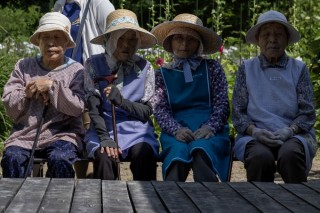Loading
Search
▼ Japan's Population Crisis in Three Numbers
- Category:Other
Japan's population is in freefall, with fewer babies born, more elderly in the workforce, and a shrinking number of residents overall.
The country faces a demographic crisis that policymakers fear threatens its economy and social welfare systems, with the Secretary of the Japanese Cabinet, Yoshimasa Hayashi, warning the country only has until the 2030s to reverse the country's plummeting birth rate.
Japan's Ministry of Internal Affairs and Communications did not immediately respond to a written request for comment.
"Japan is addressing its population decline through child-rearing policies, digitalization, and work-style reforms, aiming to enable more women and elderly citizens to contribute actively to society and the economy," Japan's Ministry of Foreign Affairs assistant press secretary Masashi Mizobuchi told Newsweek.
Below are the three main issues Tokyo is having to deal with.
Aging Population
According to a report released by Japan's Ministry of Internal Affairs and Communications, there are now 36.25 million people aged 65 and older in the East Asian nation. This equates to 29 percent of its population, the highest proportion of any other country or region in the world.
At the same time, many elderly citizens remain in the workforce. For the 20th consecutive year, the number of older workers increased, reaching a record 9.14 million.
Although many Japanese companies enforce a mandatory retirement age of 60, the government encourages firms to retain older employees who wish to continue working. This flexibility helps bridge the gap until pensions kick in at age 65, offering modified pay and working conditions to accommodate older workers.
Falling Birth Rates
Japan recorded 350,074 births between January and June, reflecting a nearly 6 percent decline from the previous year, according to health ministry statistics. This was the lowest figure since 1969, when Tokyo began posting these figures.
It also marks the third year in a row with fewer than 400,000 births in the first half of the year. This was an even greater drop than the 3.6 percent decline seen during same period last year.
Japan's fertility rate last year dipped to 1.2 births expected per woman, among the lowest in the world. Health Minister Keizo Takemi has called the situation "extremely critical," and warned Japan has only until the 2030s to reverse the trend.
Outgoing Prime Minister Fumio Kishida has made boosting the birth rate a national priority, previously pledging to double national childcare spending within a decade.
Population Decline
Japan's population shrank for the 15th consecutive year in 2023, according to government statistics release in July.
As of January 1, Japan's total population, which peaked in 2009, stood at 124.89 million. Of this total, approximately 3.32 million were foreign nationals.
Despite Japan's historically strict immigration policies, the number of foreign residents has been rising since a brief pause during the COVID-19 pandemic.
The country faces a demographic crisis that policymakers fear threatens its economy and social welfare systems, with the Secretary of the Japanese Cabinet, Yoshimasa Hayashi, warning the country only has until the 2030s to reverse the country's plummeting birth rate.
Japan's Ministry of Internal Affairs and Communications did not immediately respond to a written request for comment.
"Japan is addressing its population decline through child-rearing policies, digitalization, and work-style reforms, aiming to enable more women and elderly citizens to contribute actively to society and the economy," Japan's Ministry of Foreign Affairs assistant press secretary Masashi Mizobuchi told Newsweek.
Below are the three main issues Tokyo is having to deal with.
Aging Population
According to a report released by Japan's Ministry of Internal Affairs and Communications, there are now 36.25 million people aged 65 and older in the East Asian nation. This equates to 29 percent of its population, the highest proportion of any other country or region in the world.
At the same time, many elderly citizens remain in the workforce. For the 20th consecutive year, the number of older workers increased, reaching a record 9.14 million.
Although many Japanese companies enforce a mandatory retirement age of 60, the government encourages firms to retain older employees who wish to continue working. This flexibility helps bridge the gap until pensions kick in at age 65, offering modified pay and working conditions to accommodate older workers.
Falling Birth Rates
Japan recorded 350,074 births between January and June, reflecting a nearly 6 percent decline from the previous year, according to health ministry statistics. This was the lowest figure since 1969, when Tokyo began posting these figures.
It also marks the third year in a row with fewer than 400,000 births in the first half of the year. This was an even greater drop than the 3.6 percent decline seen during same period last year.
Japan's fertility rate last year dipped to 1.2 births expected per woman, among the lowest in the world. Health Minister Keizo Takemi has called the situation "extremely critical," and warned Japan has only until the 2030s to reverse the trend.
Outgoing Prime Minister Fumio Kishida has made boosting the birth rate a national priority, previously pledging to double national childcare spending within a decade.
Population Decline
Japan's population shrank for the 15th consecutive year in 2023, according to government statistics release in July.
As of January 1, Japan's total population, which peaked in 2009, stood at 124.89 million. Of this total, approximately 3.32 million were foreign nationals.
Despite Japan's historically strict immigration policies, the number of foreign residents has been rising since a brief pause during the COVID-19 pandemic.
- September 17, 2024
- Comment (0)
- Trackback(0)


